|
REVIEW
by Frank Turley
The forging guide is written in Spanish and is profusely illustrated with carefully done line drawings.
It is a how-to book which is well outlined for the serious student of blacksmithing.
A friend told me once, "I can't read Spanish, but I can read pictures!"
Although he said it tongue in cheek, I feel that if a reader is literate only in English, he would still gain much from this book.
The smithing lessons in the guide are thoughtfully ordered, beginning with historical and contemporary extractive ferrous metallurgy.
Next is a thorough discussion of the tools and equipment used in the artist-blacksmith studio.
This section is fairly up-to-date and does not exclude such things as drill presses, pistol drills, pneumatic power hammers, and cutoff machinery.
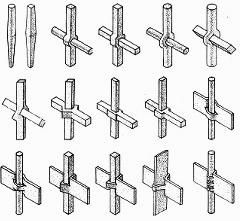 The largest section of this book is devoted to "basic processes" beginning with pointing a bar and ending with forge welding and chain making.
The processes shown are very well done in terms of both text and drawings.
Some especially good areas covered are hot splitting, threading one bar through the other, and forge welding.
The largest section of this book is devoted to "basic processes" beginning with pointing a bar and ending with forge welding and chain making.
The processes shown are very well done in terms of both text and drawings.
Some especially good areas covered are hot splitting, threading one bar through the other, and forge welding.
There are two brief portions of the guide, one devoted to heat treatment and the other to cleaning and finishing the metal. The heat treatment discussion does not broach the subject of alloy steels and is only two and one half pages in length.
The metal finishing chapter is a meager overview covering four pages of text.
The book has an interesting and thoughtful finale.
The authors show how to make six grilles, each one representing a period of history.
The periods dealt with are the:
Roman;
Gothic;
Renaissance;
Baroque;
Modern;
and Contemporary.
By studying these grills, a student can gain a good understanding of the ironwork styles extant in Europe.
The study would serve a a primer in art history, at least regarding ironwork.
These grillework lessons I would classify as "advanced".

 Spanish language terminology will vary somewhat from one country to another.
For example a Venezuelan friend calls a vise a prensa, and in other Latin countries it is a tornillo.
In the guide, to forge weld is soldar al fuego. In Mexico, the verb caldear is used whenever there is a forge weld.
However, this should prove no problem to a person fluent in Spanish.
Spanish language terminology will vary somewhat from one country to another.
For example a Venezuelan friend calls a vise a prensa, and in other Latin countries it is a tornillo.
In the guide, to forge weld is soldar al fuego. In Mexico, the verb caldear is used whenever there is a forge weld.
However, this should prove no problem to a person fluent in Spanish.
Overall, the Guía Practica de la Forja Artistica has a thoughtfully planned format and presentation.
The line drawings are particularly useful for anyone seriously pursuing artistic blacksmithing.
|
Machine translation from the Spanish review
Procedure of work
In order to perforate it is used, if it is necessary, a
layout group, the hole with a leader is marked, and next, with the
tajadera or chisel, two cuts by both sides of the bar occur, in order
to avoid an excessive crushing of this one. The length of the crack
depends on the material that is had to make happen through the hole.
The cleaved opening is high and mighty stressing the bar either
introducing a striker pin through the hot iron by both sides, trying
to work at the end of the operation on the holes of the anvil, or on a
board of putting in. The hole with the suitable mandril (round,
square or flat) of alternating form by both sides is extended.
Finally the contours dream up, review the outer surfaces of the hole
with a flat one of forge and the hole with mandril prepared to the
effect is calibrated, that is to be something more thickness than the
crossover bar.
|
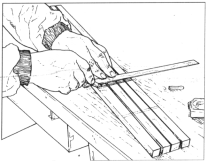 2. Layout
2. Layout |
 3. Flattened of the edge of the bar.
3. Flattened of the edge of the bar. |
 4. Punched with chisel of narrow edge.
4. Punched with chisel of narrow edge. |
 5. Opening of the eye with round striker pin.
5. Opening of the eye with round striker pin. |
 6. Sizing of the eye for square bar.
6. Sizing of the eye for square bar. |
 7. Sizing of the eye for round bar.
7. Sizing of the eye for round bar. |
|
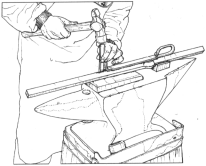

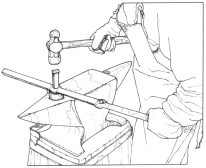
|
ABOUT THE REVIEWER:
Frank Turley is the owner and operator of The Turley Forge Blacksmithing School in Santa Fe, NM
and a popular demonstrator and guest instructor at schools world wide.
Frank's website is at www.turleyforge.com
Frank is the co-author of Southwestern Colonial Ironwork with Marc Simmons.
Published by:
Editorial de los Oficios
León, Spain
Available in January 2005 from:
ArtisanIdeas.com
Price 39€
ISBN 84-605-7070-3
|
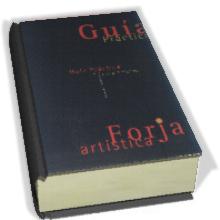



 2. Layout
2. Layout 3. Flattened of the edge of the bar.
3. Flattened of the edge of the bar. 4. Punched with chisel of narrow edge.
4. Punched with chisel of narrow edge. 5. Opening of the eye with round striker pin.
5. Opening of the eye with round striker pin. 6. Sizing of the eye for square bar.
6. Sizing of the eye for square bar. 7. Sizing of the eye for round bar.
7. Sizing of the eye for round bar.


